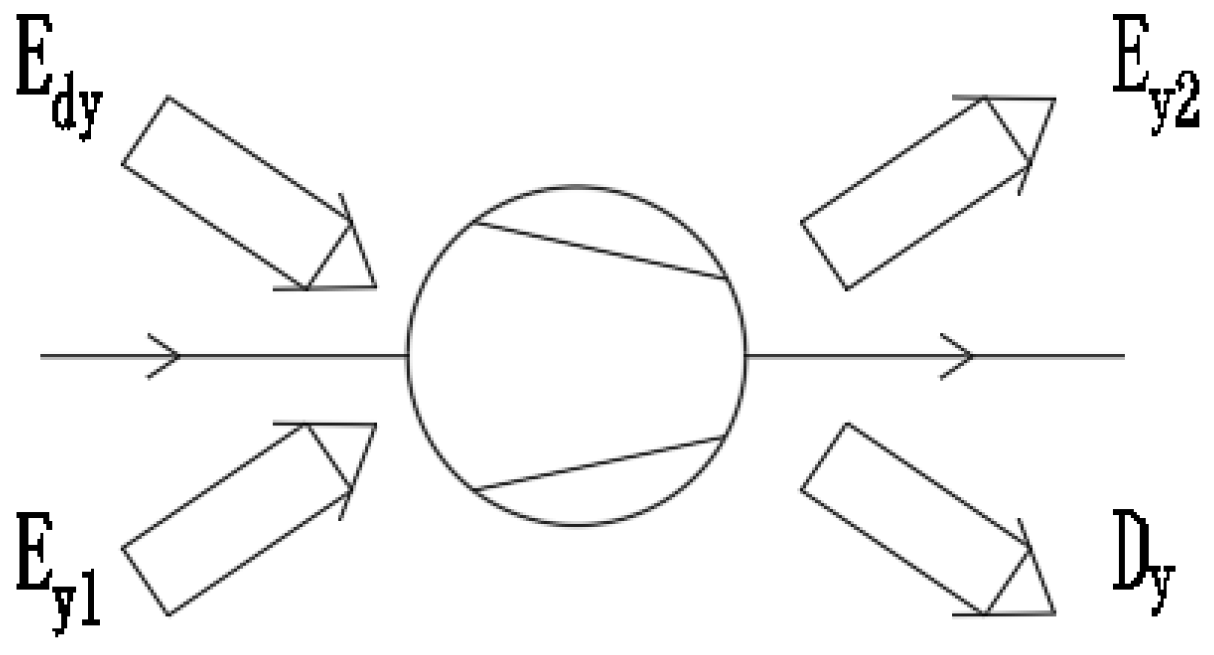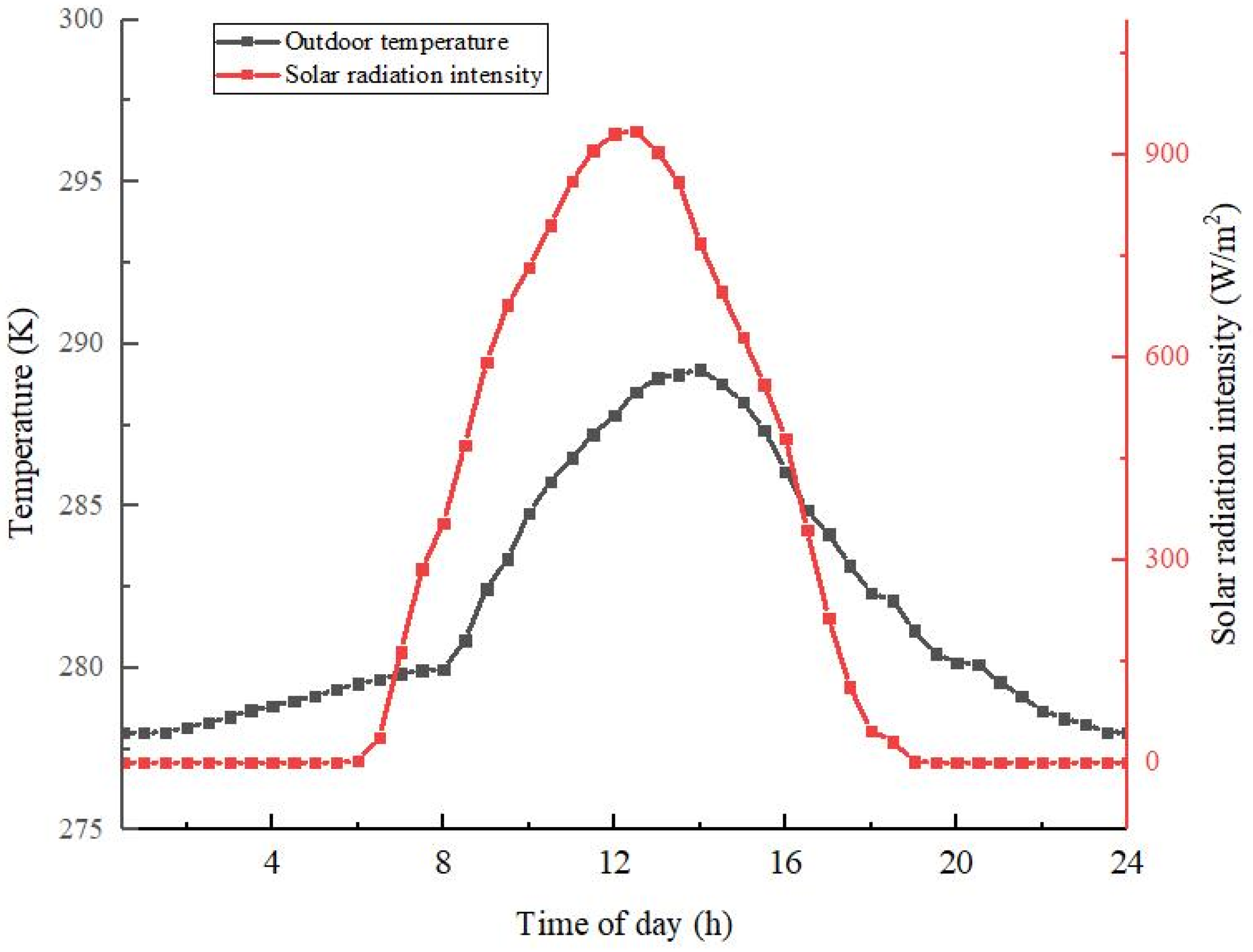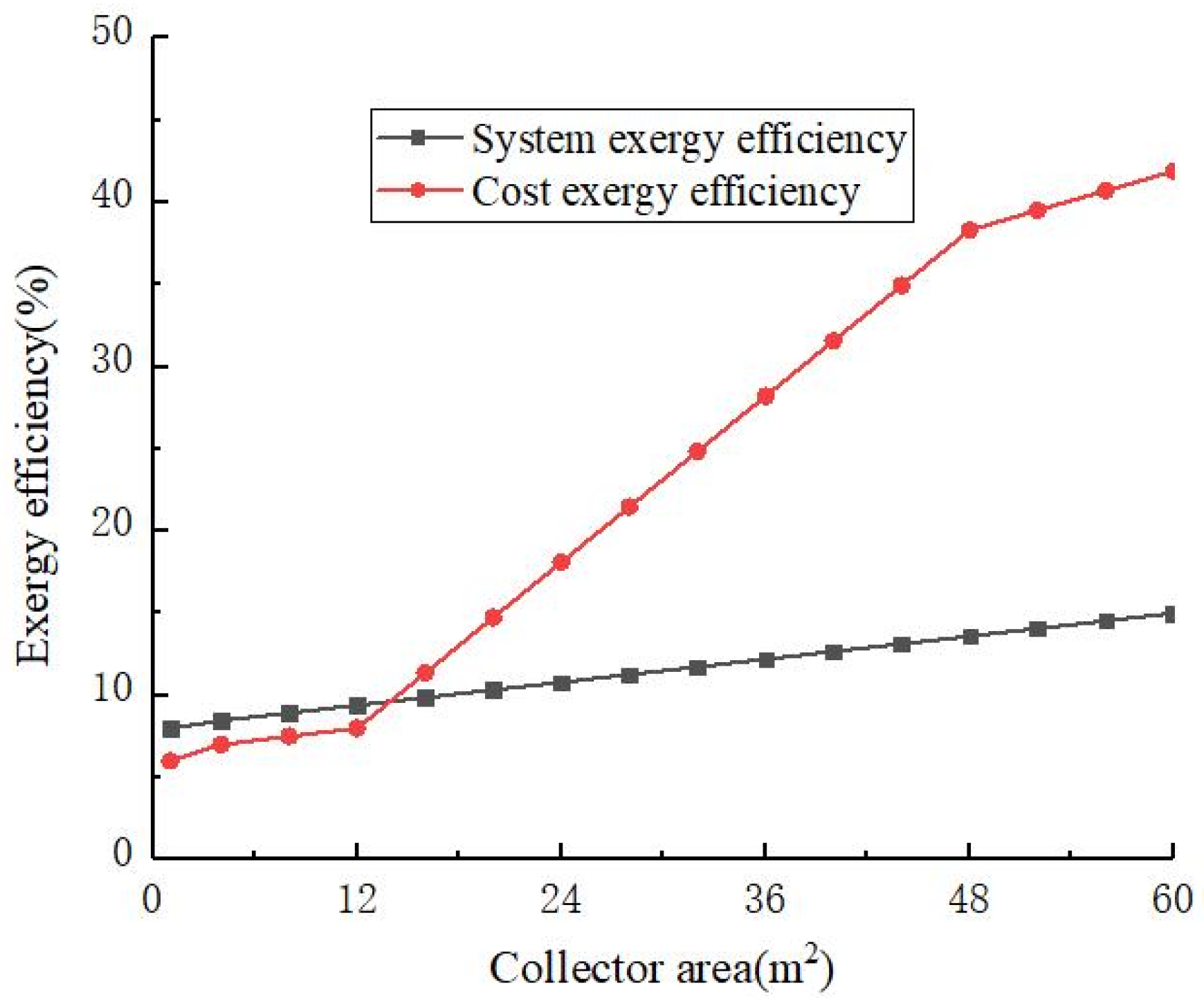Exergy Analysis of Phase-Change Heat-Storage Coupled Solar Heat Pump Heating System
Abstract
:1. Introduction
2. Materials and Methods
2.1. Phase-Change Heat-Storage Coupled Solar Heat Pump System
2.2. Model Assumptions
- (1)
- The fluid flow in the circulation is steady-state flow.
- (2)
- The influence of kinetic energy and potential energy is neglected.
- (3)
- The environment state is set to a constrained dead state.
- (1)
- The non-isentropic compression process of the working fluid in the compressor.
- (2)
- Condenser and evaporator heat transfer processes with limited temperature differences.
- (3)
- The process in which the working fluid in the solar collector absorbs solar radiant heat.
- (4)
- The heat absorption and release process of the working fluid in the phase-change heat-storage tank.
- (5)
- The throttling process of the throttle valve.
- (6)
- The mixing process of the working fluid in the suction pipe of the compressor.
2.3. Indoor Income Exergy
2.4. Exergy Equation of Solar Collectors
2.5. Phase-Change Heat-Storage Tank Exergy Balance Equation
2.6. Exergy Analysis of Heat Pump System
- (a)
- (b)
- Exergy loss of motor.
- (c)
- Compressor exergy loss.
- (d)
- Exergy loss of throttle valve.
- (e)
- Condenser exergy loss [7].
- (f)
- Evaporator exergy loss.
- (g)
- Heat pump system exergy efficiency .
2.7. System Evaluation Indicators Based on Exergy Analysis
3. Results and Discussion
3.1. Analysis of Influence of Area of Solar Collector on Exergy Efficiency of System
3.2. Influence of Phase-Change Heat-Storage Tank Volume on Exergy Efficiency of System
3.3. Influence of Other Factors on Efficiency of System
4. Conclusions
- (1)
- When the area of the solar collector was 48.2 m2, the cost exergy was small, and the cost exergy efficiency reached 38.3%. According to the integrity characteristics of the solar collector, a solar collector area of 48 m2 was optimal. Air-type solar collectors can increase the profitability of solar collectors, so this design is beneficial.
- (2)
- When the volume of the phase-change heat-storage tank was 2.6 m3, the cost of the system input reached the lowest value of 3.4 × 105 kJ. The volume of the optimized phase-change heat-storage tank changed from 2.5 to 2.6 m3.
- (3)
- The heat exchange efficiency of the heat exchanger at the end of heating should be improved, as it can reduce the exergy loss of the system. When conditions permit, this heat exchanger should be combined with a heat pump system for heating. The capillary tube in the heat pump system can be replaced with an electronic expansion valve, which can reduce the exergy loss of the heat pump system.
Author Contributions
Funding
Informed Consent Statement
Data Availability Statement
Acknowledgments
Conflicts of Interest
References
- Penrod, E.B.; Prasanna, K.V. Design of a Flat-Plate Collector for a Solar Earth Heat Pump. Sol. Energy 1962, 6, 9–22. [Google Scholar] [CrossRef]
- Penrod, E.B.; Prasanna, K.V. Procedure for Designing Solar- Earth Heat Pump Heating. Pip. Air-Cond. 1969, 41, 97–100. [Google Scholar]
- Plytaria, M.T.; Tzivanidis, C.; Bellos, E.; Antonopoulos, K.A. Energetic investigation of solar assisted heat pump underfloor heating systems with and without phase change materials. Energy Convers. Manag. 2018, 173, 626–639. [Google Scholar] [CrossRef]
- Ozgener, O.; Hepbasli, A. A parametrical study on the energetic and exergetic assessment of a solar-assisted vertical ground-source heat pump system used for heating a greenhouse. Build. Environ. 2007, 42, 11–24. [Google Scholar] [CrossRef]
- Kuang, Y.; Zhang, K.; Yu, L.; Zhang, X. A Thermodynamic Analysis of Solar Heat Pump System. J. Qingdao Univ. Technol. 2001, 22, 80–83. [Google Scholar]
- Wang, H. Thermodynamic analysis of solar heat pump system. In Proceedings of the Shandong HVAC & Refrigeration 2007 Annual Conference, Qingdao, China, 1 June 2007; Volume 2, pp. 348–353. [Google Scholar]
- Zhao, F.; Yang, Q.M.; Kong, X.Q.; Yi, Q.J. Exergy Analysis for Experimental System of Solar Assisted Heat Pump Multi-function Machine. Fluid Mach. 2007, 35, 66–69. [Google Scholar]
- Cervantes, J.G.; Torres-Reyes, E. Experiments on a solar-assisted heat pump and an exergy analysis of the system. Appl. Therm. Eng. 2002, 22, 1289–1297. [Google Scholar] [CrossRef]
- Pei, G. Research on Comprehensive Performance of Photovoltaic-Solar Heat Pump System and Multifunctional Heat Pump System; University of Science and Technology of China: Hefei, China, 2006. [Google Scholar]
- Zhu, C.; Li, B.; Yan, S.; Luo, Q.; Li, C. Experimental research on solar phase change heat storage evaporative heat pump system. Energy Convers. Manag. 2021, 229, 113683. [Google Scholar] [CrossRef]
- Zhu, C.; Li, B.; Yang, H.; Luo, Q. Preparation of ammonium aluminum sulfate dodecahydrate/stearic acid composite material and its phase-change heat-transfer characteristics. Int. J. Energy Res. 2020, 44, 2061–2071. [Google Scholar] [CrossRef]
- Chu, G. Research on optimization of solar heat pump system based on exergy analysis. Intell. City 2017, 3, 157. [Google Scholar]
- Qu, S.; Peng, L.; Ma, F.; Chen, C. Optimization on solar-assisted heat pump system based on exergy analysis. J. Nanjing Univ. Sci. Technol. 2013, 37, 122–126. [Google Scholar]
- Torres-Reyes, E.; Picon-Nunez, M.; Cervantes-De, G.J. Exergy analysis and optimization of a solar assisted heat pump. Energy 1998, 23, 337–344. [Google Scholar] [CrossRef]
- Li, Y.W.; Wang, R.Z.; Wu, J.Y.; Xu, Y.X. Experimental Performance Analysis and Optimization of a direct expansion solar assisted heat pump water heater. Acta. Energ. Sol. Sin. 2007, 28, 464–471. [Google Scholar] [CrossRef]
- Yao, L. Exergy analysis of refrigeration and heat pump systems. Appl. Therm. Eng. 2000, 2, 1–3. [Google Scholar]
- Qu, S.; Peng, L.; Wu, X.; Hu, J. Optimization research of solar-assisted heat pump system based on energy anslysis and exergy analysis. Acta Energ. Sol. Sin. 2015, 36, 2384–2389. [Google Scholar]
- Zhu, C.; Yan, S.; Mei, C.; Li, B.; Luo, Q. Simulation Analysis of a Novel Phase Change Thermal Storage Solar Collector. In Proceedings of the 2021 4th International Conference on Energy, Electrical and Power Engineering (CEEPE), Chongqing, China, 23 April 2021; pp. 1125–1129. [Google Scholar]








Publisher’s Note: MDPI stays neutral with regard to jurisdictional claims in published maps and institutional affiliations. |
© 2021 by the authors. Licensee MDPI, Basel, Switzerland. This article is an open access article distributed under the terms and conditions of the Creative Commons Attribution (CC BY) license (https://creativecommons.org/licenses/by/4.0/).
Share and Cite
Zhu, C.; Yan, S.; Dong, X.; Zhang, W.; Huang, B.; Cui, Y. Exergy Analysis of Phase-Change Heat-Storage Coupled Solar Heat Pump Heating System. Materials 2021, 14, 5552. https://doi.org/10.3390/ma14195552
Zhu C, Yan S, Dong X, Zhang W, Huang B, Cui Y. Exergy Analysis of Phase-Change Heat-Storage Coupled Solar Heat Pump Heating System. Materials. 2021; 14(19):5552. https://doi.org/10.3390/ma14195552
Chicago/Turabian StyleZhu, Chuanhui, Shubin Yan, Xiaodong Dong, Wei Zhang, Biyi Huang, and Yang Cui. 2021. "Exergy Analysis of Phase-Change Heat-Storage Coupled Solar Heat Pump Heating System" Materials 14, no. 19: 5552. https://doi.org/10.3390/ma14195552





